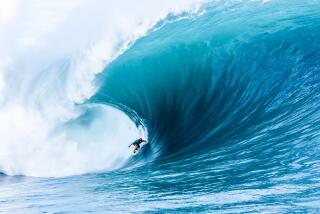Around-the-World Sailing Race : Frenchman Wins Second Leg in Record Time
- Share via
NEWPORT, R.I. — Titouan Lamazou, aboard Ecureuil d’Aquitaine of France, won the second leg of the BOC Challenge solo around-the-world sailing race, arriving in Sydney, Australia, from Cape Town, South Africa, in 28 days 7 hours 13 minutes.
The time for the 6,300 nautical miles was seven days faster than the mark set by Philippe Jeantot aboard Credit Agricole in the first race in 1982.
Jeantot, 35, aboard Credit Agricole III, also broke his own record, finishing 5 hours 39 minutes behind Lamazou.
For the entire race, which began here in September, Jeantot is ahead by 3 days 10 hours, with a total elapsed time of 71 days 5 hours 50 minutes.
Jean Yves Terlain, 42, was third in the Cape Town-Sydney leg, arriving aboard UAP Pour Medicins Sans Frontieres in 31 days 4 hours 55 minutes. He crossed the finish line under only a staysail, one of the smallest sails in his inventory. All the rest were torn or in shreds.
All three finishers were 60-foot Class 1 entries.
Meanwhile, Thursday’s Child, Warren Luhrs’ American entry, was dismasted Thursday 185 miles south of Sydney. Luhrs reported that he has anchored and that his support crew was en route from Sydney. A backup mast has been ordered flown from the United States.
Luhrs, 41, a favorite of many to win, was delayed 24 hours at the Newport start by collision damage. He lost three more days after the start from Cape Town when he was forced to return to port with equipment failures. A week ago, his boom broke in a gale. He replaced it with a spinnaker pole.
It was a harrowing, storm-battered leg for the early finishers.
Lamazou, 31, lost water containers in a capsize in the Indian Ocean and was forced to scrape the condensation from his mainsail to quench his thirst during the last 36 hours of the leg.
“I was very worried about Philippe, especially during the last week,” Lamazou said. “He had the best wind and was coming so fast.
The Moroccan-born sailor said he panicked a few times when he saw large sailboats coming up fast behind him as he approached Sydney, but they turned out to be cruising boats under power, not racers.
Both Lamazou and Jeantot averaged about 230 miles a day, or 9.6 knots--nautical miles per hour--throughout the leg, an unprecedented pace for solo sailing.
Lamazou’s advantage lay chiefly in his decision to sail a more southerly--and thus shorter--course right from the start. Jeantot hesitated in the mid-40-degree latitudes for a time before diving south to 50 degrees in hot pursuit of Lamazou and Terlain, the leaders at that time.
Jeantot arrived in Sydney unhappy with his boat designer, Guy Ribadeau-Dumas. He told race officials that he had been pumping 100 gallons of water an hour out of his boat for days because of a leak between the keel and the hull.
He had arrived in Cape Town with the same problem, but thought it had been fixed by Ribadeau-Dumas.
Jeantot said that just before the Cape Town start, however, the designer surprised him with the warning: “Be careful. I’m not sure about the keel.”
Ribadeau-Dumas was reported en route to Sydney from France.
“I have something for him when he gets here,” Jeantot said, only half joking.
The rest of the gale-whipped fleet was proceeding toward Sydney in reasonably good order, despite a myriad of problems that included broken spars, ripped sails and destroyed automatic steering systems.
Jacques de Roux, 49, first among the Class 2 boats aboard Skoiern IV, doggedly held the lead over rival Mike Plant on America’s Airco Distributor, despite another knockdown that ripped away masthead instruments and a radio antenna.
De Roux already was reduced to hand steering for hours on end because an earlier rollover had carried away his wind vane steering and his wheel steering apparatus. He is a using an emergency tiller.
At midweek, De Roux was 80 miles ahead of Plant. Both were in the Bass Strait between Australia and Tasmania.
Richard Konkolski, aboard Declaration of Independence, appeared to be the only skipper in the fleet shaping a course south of Tasmania, avoiding the Bass Strait with its multitude of hazards.
Spectators at Credit Agricole’s high-noon finish were witness to a memorable incident.
As Jeantot approached the finish line at Sydney Heads, his boat leaking, worn from 28 days of intense racing through the wildest seas on earth, one of the spectator boats wheeled in front of him, set a spinnaker and started to run toward the harbor entrance.
The boat was the South-African owned, Atlantic Privateer, an 80-foot long, world-class ocean racer with a full crew on board.
One more time, Jeantot set his huge, 3,200-square-foot nylon spinnaker, strapped in the sheet, braced the spinnaker pole and charged for the line.
When he crossed it, Atlantic Privateer was astern.


